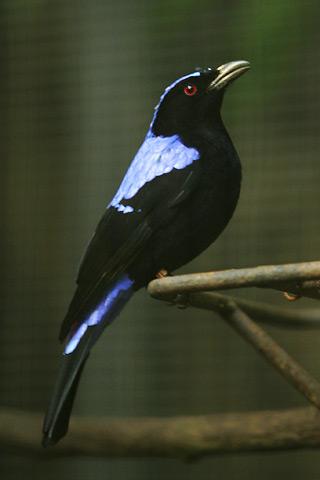- Asian Fairy Bluebird
Taxobox
name = Asian Fairy Bluebird
status = LC | status_system = IUCN3.1

image_width = 225px
image_caption = male
regnum =Animal ia
phylum = Chordata
classis = Aves
ordo =Passeriformes
familia = Irenidae
genus = "Irena "
species = "I. puella"
binomial = "Irena puella"
binomial_authority = (Latham, 1790)The Asian Fairy Bluebird, "Irena puella", is a medium-sized, arboreal
passerine bird .This
fairy-bluebird breeds across tropical southern Asia from the Himalayan foothills,India andSri Lanka east toIndonesia . This species is found in moist hill-forest. Two or three eggs are laid in a small cup nest in a tree.The adult Asian Fairy Bluebird is about 27 cm long. The male has glossy, iridescent blue upperparts, and black underparts and flight feathers. The female and first year male are entirely dull blue-green.
The Asian Fairy Bluebird eats fruit, nectar and some insects. Its call is a liquid two note "glue-it".
Description
Male. The whole upper plumage, the lesser wing-coverts, and the under tail-coverts shining ultramarine-blue with lilac reflections; sides of the head and the whole lower plumage deep black ; greater wing-coverts, quills, and tail black, some of the coverts tipped with blue, and the middle tail-feathers glossed with blue. Female. The whole upper plumage, the lesser wing-coverts, and the lower tail-coverts brownish blue, with the edges of the feathers brighter ; middle tail-feathers and the outer webs of all the others, except the outer pair, like the upper plumage ; remainder of tail dark brown ; primaries and secondaries dark brown ; the greater wing-coverts, primary- coverts, and tertiaries dark brown, with a blue tinge on the outer webs ; sides of the head and whole lower plumage blue, very similar to the upper parts. The young are like the female. The male changes into adult plumage about March, and the change takes place without a moult ; the feathers of the upper parts first become fringed with bright blue ; the tail-coverts next become changed ; the lower plumage takes the longest to change, and young birds may frequently be met with having the lower plumage mixed black and dull blue, hut the upper plumage that of the adult.
Iris crimson ; eyelids pinkish ; bill and legs black ; mouth flesh- colour; claws black. Length 10.5; tail 4.2 ; wing 5.1; tarsus .85; bill from gape 1.2inches.
"I. cyanea", from the Malay peninsula, differs in having the under tail-coverts longer, nearly reaching to the tip of the tail. �Distribution. Ceylon ; the western coast of India from Travancore up to the latitude of Belgaum and Sawantwadi; Sikhim and the lower ranges of the Himalayas to Dibrugarh in Assam ; the Khasi hills ; Cachar ; Manipur ; Arrakan ; Pegu ; Tenasserim ; the Audamans and Xicobars. This species is confined entirely to the evergreen forests of the hills and plains, and it is found up to about 4000 feet of elevation. It extends some distance down the Malay peninsula and into Siam.
This bird is common in most of the tracts it frequents, going about in small parties or in pairs. It feeds principally on fruit and is generally found on the larger forest-trees. It breeds from February to April, constructing a shallow cup-shaped nest, sometimes of moss and sometimes of small twigs, in a sapling or small tree. The eggs, which are generally two in number, are greenish white marked with brown, and measure about 1.14 by .77. [Oates, E. W. (1889) Fauna of British India. Birds. Volume 1.]
Gallery
Notes
References
* Database entry includes justification for why this species is of least concern
* "Birds of India" by Grimmett, Inskipp and Inskipp, ISBN 0-691-04910-6External links
* [http://ibc.hbw.com/ibc/phtml/especie.phtml?idEspecie=7975 Asian Fairy Bluebird videos] on the Internet Bird Collection
Wikimedia Foundation. 2010.
